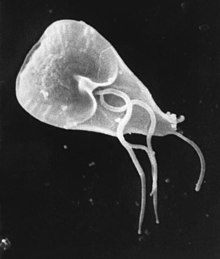
Back جياردية Arabic جيارديه ARZ Lyambliya Azerbaijani Giardia Catalan Giardia (dawhilahila) CEB Giardien German Giardia Estonian ژیاردیا Persian Giardia French Giardia Galician
| Giardia | |
|---|---|

| |
| Giardia trophozoite, SEM | |
| Scientific classification | |
| Domain: | Eukaryota |
| Phylum: | Metamonada |
| Order: | Diplomonadida |
| Family: | Hexamitidae |
| Subfamily: | Giardiinae |
| Genus: | Giardia Künstler, 1882[1] |
| Species | |
| Synonyms | |
| |
Giardia (/dʒiːˈɑːrdiə/ or /ˈdʒɑːrdiə/) is a genus of anaerobic flagellated protozoan parasites of the phylum Metamonada that colonise and reproduce in the small intestines of several vertebrates, causing the disease giardiasis. Their life cycle alternates between a swimming trophozoite and an infective, resistant cyst. Giardia were first described by the Dutch microscopist Antonie van Leeuwenhoek in 1681.[3] The genus is named after French zoologist Alfred Mathieu Giard.[4]
- ^ Künstler, J. (1882). "Sur cinq protozoaires parasites nouveaux". C. R. Acad. Sci. Paris. 95: 347–349.
- ^ Blanchard, R. (1888). "Remarques sur le megastome intestinal". Bull. Soc. Zool. Fr. 30: 18–19.
- ^ Stanley L. Erlandsen, Ernest A. Meyer (1 March 1984). Giardia and Giardiasis: Biology, Pathogenesis, and Epidemiology. Springer. pp. 131–. ISBN 978-0-306-41539-5.
- ^ Adam RD (July 2001). "Biology of Giardia lamblia". Clin. Microbiol. Rev. 14 (3): 447–75. doi:10.1128/CMR.14.3.447-475.2001. PMC 88984. PMID 11432808.
© MMXXIII Rich X Search. We shall prevail. All rights reserved. Rich X Search